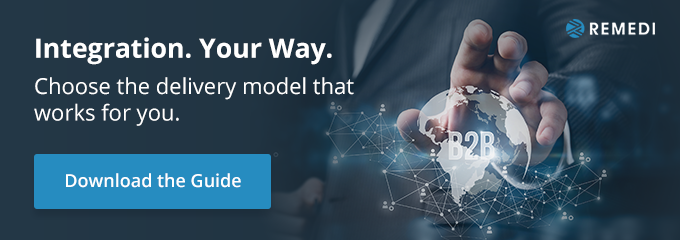
Increasingly, digital transformation and Industry 4.0 dominate the modern business landscape. That means seamless data integration has become a critical piece of organizations’ growth strategies.
As companies come to rely more on interconnected systems and diverse data sources, they will need to navigate more integration challenges. In this blog post, we’ll explore those challenges and how entities can best overcome them.
Most importantly, we’ll delve into the emerging trends and technologies that are reshaping data integration. As the pace of integration technology’s evolution picks up, staying abreast of these transformative developments will become a strategic imperative for enterprises that want to harness the full potential of their data-driven operations.
The Current State of Integration
In the current integration landscape, Electronic Data Interchange and modern data integration methods converge to ease the exchange of structured data between businesses. With EDI as a pillar of these exchanges, contemporary integration practices have broadened, and now encompass a wide swathe of data types and formats.
But this evolving terrain comes with some formidable integration challenges. The coexistence of legacy systems and the demands of Industry 4.0 – the confluence of technological advancements now happening in manufacturing – can create disparate data silos, blocking the seamless flow of information. And as data volumes increase and business ecosystems grow, traditional integration methods can show their limitations, often manifesting as inefficiencies, data inconsistencies and missed business opportunities.
Fixing these problems calls for a thorough understanding of the challenges companies face and a strategic use of emerging integration technologies.
Emerging Trends in Integration
There are a number of important trends now emerging that, driven by digital transformation, are shaping the future of integration. A prominent one is the rise of Application Programming Interface ecosystems, which encourage easy communication among diverse applications.
Another is the growing emphasis on agile integration, which is enabling businesses to adapt quickly to changing market factors. In an age in which speed and flexibility are expected of companies, rapid and precise integration methodologies are a must. They allow your organization to integrate new technologies rapidly, adapt to evolving business models and extract real-time insights from disparate data sources.
Understanding and using these trends to your advantage will soon be essential to retaining a competitive edge.
1. API-Based Integration
API-based integration entails using APIs to allow for communication and data exchange between different software applications and systems. APIs are intermediaries that let applications interact with each other by defining the methods and protocols needed for communication.
Through standardized interfaces, APIs facilitate easy data exchange, promoting interoperability and allowing businesses to integrate different technologies, boost functionality and consolidate operations.
2. IoT Integration
The Internet of Things is a critical part of integration because it connects numerous devices and generates vast amounts of data. As the number of available IoT devices increases, the data these devices generate becomes a valuable resource for businesses. To get the most out of this data and cull meaningful insights from it, integration with existing systems is a must. It will ensure a cohesive, unified approach to leveraging the varied information types coming from IoT devices.
3. AI and Machine Learning Integration
AI and machine learning are changing integration by automating complex processes and improving data-analytics capabilities. In data integration, AI-driven analytics play a vital part by decoding patterns, forecasting trends and improving decision-making processes. This technology empowers businesses to get actionable insights from huge datasets, facilitating more informed and strategic decision making in integration.
4. Cloud-Based Integration
Cloud-based integration solutions present a multitude of benefits, providing entities with scalability, flexibility and greater accessibility. Cloud platforms offer easy expansion or contraction of resources based on your business needs, ensuring cost efficiency and optimal performance.
The move from traditional, onsite integration to cloud-based solutions represents a turning point. It is allowing businesses everywhere to adapt more easily to changing requirements, reduce their infrastructure costs and generally embrace a more agile, responsive integration framework.
5. Blockchain Integration
Blockchain technology holds tremendous potential for integration because of its ability to ensure secure, transparent data exchange. Because it is decentralized and cryptographic, it bolsters data integrity, providing a secure ledger that greatly mitigates the risk of tampering or unauthorized access.
Through smart contracts and distributed consensus mechanisms, blockchain encourages trust in data transactions, offering a strong foundation for secure, transparent integration.
6. Low-Code/No-Code Integration
Low-code and no-code integration platforms simplify the process of creating integrations by allowing non-technical users to build applications with minimal coding. These platforms offer intuitive, user-friendly interfaces, pre-built templates and visual development tools that don’t require extensive programming knowledge to design and implement integrations.
This democratization of integration speeds the development cycle and fosters collaboration between technical and non-technical stakeholders, bridging the gap and promoting efficiency in the creation of interconnected systems.
The Impact of Industry 4.0

Marked by automation and data exchange, Industry 4.0 is a catalyst for integration trends. Why? Because organizations are continually striving for interconnected, intelligent systems.
Integration is a pivotal part of smart manufacturing and supply chain optimization. It paves the way for the seamless flow of data between machines, processes and stakeholders.
By using integration technologies, businesses can achieve real-time visibility, predictive analytics and enhanced collaboration, allowing them to be both more efficient and more innovative.
Overcoming Integration Challenges
Adopting new integration technologies often comes with challenges. These include legacy system compatibility, data security concerns and resistance to change. You can overcome these hurdles, however, by undertaking comprehensive assessments of your existing systems, prioritizing modular approaches for integration and implementing strong data encryption and access controls.
Creating a culture of adaptability through training programs and clear communication can help organizations over the complexities inherent in adopting new integration technologies.
Preparing for the Future
To prepare for these integration trends, businesses should invest in continuous education so their teams stay informed about evolving technologies. Prioritizing scalable, flexible integration solutions will also ensure adaptability to changing demands, allowing businesses to maintain their competitive edge.
Conclusion
As we’ve seen, integration is undergoing a sizable shift thanks to the emergence of various new trends and technologies. From API ecosystems and AI, to cloud solutions and low-code platforms, the necessity of adaptability is clear. Businesses that want to future-proof their operations should proactively embrace these trends and support cultures of ongoing learning and agility to overcome hurdles and unlock new opportunities.
—-----------------------
Ready to integrate? Remedi can help. Integration. Your Way. Choose the delivery model that works for you.



